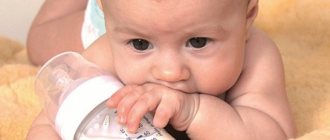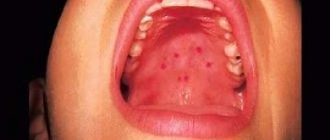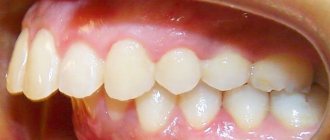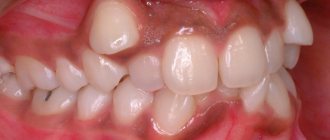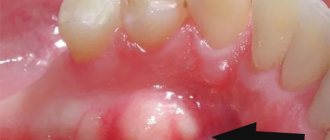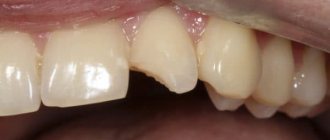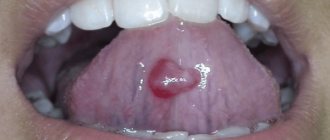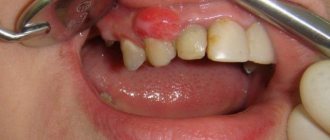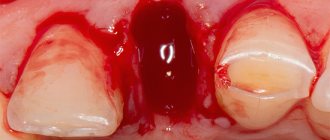Red cheeks during teething in a child: reasons, photos, Komarovsky’s opinion
Teething is a long-awaited event, but not always just joyful.
Often the child becomes whiny and irritable, has a fever or a red rash. In addition, he is worried about poor appetite, disturbed sleep, runny nose or cough. The baby refuses toys and is capricious.
What other symptoms may accompany the process of teeth appearing and how to distinguish them from the onset of the disease?
What symptoms may accompany teething?
You need to monitor your child’s oral cavity after 6–7 months – it is at this time that the first teeth are cut. Before the eruption of the lower incisors, symptoms of acute respiratory viral infections, poisoning or intestinal disorders sometimes occur. If this condition persists for a long time, then you should consult a doctor.
If parents notice a change in appetite, sleep and wakefulness, or increased salivation, the first thing to check is the gums, which swell and sometimes become inflamed before the eruption of baby teeth.
In rare cases, a whitish ball or hematoma is noticeable on them (visible in the photo); in the future, an incisor will appear in this place.
In addition, the baby’s cheeks often turn red, but this may also indicate an allergic reaction or diathesis.
Redness persists for a long time, as the teeth travel a long way, overcoming bone tissue and mucous membranes. Salivation increases, causing the baby to cough and gag. The child often refuses the breast and puts his fingers in his mouth. Loose stools, severe itching in the mouth, nose or ears, and vomiting are much less common.
Can teething cause my cheeks to turn red?
Redness of the lips, chin or cheeks is not uncommon when baby teeth emerge. Redness of the cheeks may be due to elevated temperature. Attention is paid to the symptoms accompanying this phenomenon.
If peeling, severe itching, or high temperature are detected, it is worth thinking about some pathologies. These include diathesis, an allergic reaction to any irritant, and even pneumonia.
In such cases, it is important to visit a doctor on time and adhere to the prescribed treatment regimen.
Possible causes of red cheeks in babies
As mentioned earlier, redness of the cheeks in babies does not always indicate the imminent appearance of baby teeth. Sometimes this symptom signals disorders in the body that cannot be ignored. So, the reason for the change in cheek color may be:
- Diathesis. This reason is the most common, as it occurs in 80% of children aged 6 months to 3 years. This can be explained by the tendency of a fragile body to allergies, colds or inflammatory processes. Diathesis is often diagnosed in infants who are introduced to new foods in their complementary foods. Their gastrointestinal tract is not yet able to accept such food, so foreign proteins directly enter the bloodstream. The protective functions try to fight this and release antibodies, the level of histamine increases and causes vasodilation, as a result of which the cheeks turn red.
- Allergic reaction. The baby’s body cannot yet accept certain substances; his immune system tries to fight and produces antibodies. During failures, this process is disrupted, so protective functions can perceive certain elements as hostile and fight against them. Irritants include foods, plants (especially in spring, when everything is in bloom), pet fur and bird feathers, medicines, household chemicals, and insect poisons.
- Teething. Babies after 5–6 months are bothered by inflamed and swollen gums, as well as a feeling of itching in the mouth. Such symptoms indicate the imminent appearance of the first teeth. More often, red cheeks occur due to the active work of the salivary glands or prolonged mechanical action - scratching or rubbing, as children often suck their fingers and fists, trying to get rid of unpleasant sensations.
- Pneumonia. Redness of the cheeks with this disease is observed simultaneously with pallor of the lips and tip of the nose; treatment is carried out only under the supervision of a doctor. Delayed detection of pathology increases the risk of serious complications and death. If there is a high temperature, shortness of breath, a strong lingering cough and a disturbance in the baby’s usual condition (loss of appetite, prolonged sleep, lethargy), you should urgently call an ambulance.
- Roseola. An infectious disease that causes spots all over the body. At first a small spot appears, then it grows and merges with others. You can distinguish it from an allergy in the following way: you need to press on the suspicious area and monitor the reaction. If the skin turns pale, then this is a clear symptom of roseola.
- Parasitic infection. Worms poison the human body and negatively affect the immune system. For this reason, red spots often appear on the dermis; a rash on the face sometimes indicates pinworms and giardia.
Don't worry or panic right away. Most often, redness on the cheeks occurs immediately after a walk in the cold or active play. Prolonged exposure to the sun and the baby's characteristics affect skin color. For example, many children blush from shame, embarrassment or joy.
E. O. Komarovsky about teething
Evgeny Olegovich Komarovsky is a famous pediatrician who covers issues of child health and development. He says that the first teeth begin to erupt at the age of 6 months, a process that lasts up to 2.5–3 years. It cannot be accelerated - everything is individual and depends only on genetics.
Sometimes teeth appear much later than normal. If the doctor does not diagnose kidney or endocrine diseases, then there is no need to worry. Symptoms manifest themselves in different ways, Komarovsky believes that there is no need to alleviate the baby’s condition all the time.
It is necessary to intervene when something threatens the child’s health.
Due to poor nutrition and large amounts of saliva, the appearance of incisors is often accompanied by loose stools. It also requires no treatment and only appears a few times.
Komarovsky strongly recommends treating children's teeth if there are problems. Diseases of primary teeth can negatively affect the bite and permanent units. In addition, inflammation of the oral cavity causes pathologies of the gastrointestinal tract.
Teething is an inevitable process, which is often accompanied by painful sensations and phenomena. It is important to know what symptoms precede the appearance of baby teeth in order to distinguish them from manifestations of serious diseases in time.
Source: https://AzbukaZubov.com/rebenok/prorezyvanie/krasnye-shcheki-pri-prorezyvanii-zubov.html
Common causes of red cheeks
Photo of red cheeks in a baby
When parents notice redness on the cheeks of an infant, the first thing they should do is go to the pediatrician. Self-diagnosis without the appropriate experience or knowledge will not allow you to give the only correct answer.
Sometimes the cheek may turn red due to simple cold. Redness is usually observed after walking outdoors in winter or autumn, or simply on a cold day. If after some time the cheeks return to normal, then there is no need to worry. Just next time before going outside, apply cream to your baby’s cheeks.
But there are situations when a newborn baby has redness on the cheeks caused by potentially dangerous reasons. The most common of them, requiring immediate response from parents, are:
- Diathesis;
- Allergic disease;
- Teething;
- High body temperature;
- Reaction to medications used;
- Inflammation of the lungs.
Red cheeks during teething: how to help your child?
Teething in a small child is always an exciting process, which is accompanied by many unpleasant factors for the baby. For example, pain may appear, due to which many physiological processes are disrupted, or some external signs may appear, including redness of the cheeks.
Signs indicating the process of teething
As soon as the first symptoms appear, parents will immediately notice them. The child will try to put everything in his mouth, chew his fingers, toys, and some kitchen utensils.
During this period, it is important to limit it from any sharp objects that can injure the mucous membrane.
Other manifestations include:
- Sleep disorders;
- Moodiness;
- Decreased appetite;
- Possible increase in body temperature;
- Redness of the gums, cheeks, or eyes.
The last point is of particular interest. Is it possible to diagnose teething by the redness of a baby's cheeks? There are several factors that lead to this. When body temperature rises, redness will occur in any case. And if the temperature is normal, then such a manifestation is possible due to the increased work of the salivary glands, which are preparing for the eruption of teeth.
IMPORTANT! During this period, it is necessary to carefully monitor the child’s condition so that signs of the appearance of the first teeth can be distinguished from any infectious diseases. Also, if you have doubts about the normal course of the process, you should consult a doctor to prevent possible complications or anomalies.
Other reasons why cheeks may turn red
Parents need to be careful when it comes to this sign, as there can be many reasons for this manifestation. Experts include seven conditions at once. Not all of them pose a danger to the baby’s health, but some are pathologies that require treatment.
This is what the list looks like:
- Diathesis. Manifestations will be in the form of redness of the skin, itching, inflammatory processes in the mucous membrane, the appearance of small red nodules in the bends of the limbs, in some cases there may be seborrhea. Most often it is a harbinger of food allergies.
- Pseudoallergic reaction. It manifests itself as inflammation of the skin (redness, itching, rashes), and is sometimes accompanied by disturbances in the digestive tract. In most cases, this is due to a deficiency of enzymes in the baby’s body, which because of this simply cannot digest the food offered to him. Whether it is an allergy or a pseudo-allergic reaction can only be said by a specialist who will carry out the necessary diagnostics in the laboratory.
- Natural physiology. Any person's cheeks begin to turn red during intense physical activity. It’s the same with the baby, but not during some kind of work, but when showing strong emotions. The same symptom develops when the body is overheated or hypothermic.
- Teething period. Data on this condition are presented at the beginning of this article.
- Pneumonia. During this period, the child becomes restless, the general body temperature rises, there is a decrease in appetite, sleep disturbances, digestive problems, runny nose, cough and blue discoloration of the skin between the child’s lips and nose.
It is important to understand that in this case, treatment should only be carried out under the supervision of a doctor who will make an accurate diagnosis and prescribe the necessary therapy.
- Diseases of the adrenal glands. Rapid heartbeat, indigestion, bluish skin, noticeable decrease in activity. Similar to the previous condition, identification and treatment are carried out in specialized medical institutions under the supervision of a specialist.
- Infestation with parasites. Digestive tract disorders, baby weight loss, skin rashes, sleep disturbances, possible redness or irritation in the anal area. Diagnosis and treatment are similar to the previous point.
How to help a child during this period?
To provide the necessary help, you need to understand the cause of such symptoms. Since the therapy provided will vary significantly.
IMPORTANT! In the rest of the article we will talk about teething. If you suspect any pathological process, you should immediately consult a pediatrician who will give further advice.
In cases where the cause is the process of the first teeth coming out, special medical gels can come to the rescue, significantly reducing pain and signs of inflammation. This is due to the content of lidocaine in them. For this reason, their use before feeding is not recommended.
Since this substance causes slight numbness, which will significantly complicate the process of eating for the child. The most common means:
- Dentinox. It fights pain and inflammation well.
- Kamistad - baby. It has antiseptic properties, eliminates pain and inflammation.
- Baby doctor . The effect is mainly anti-inflammatory, since the vast majority of the composition is medicinal herbs.
Using special toys
In various stores you can find toys designed for babies during the teething period. There may be cooling substances inside them that will significantly reduce the pain during this process. The method is quite safe, but it is worth considering the size of the toy that is offered to the baby in order to exclude the possibility of swallowing.
It is recommended to place it in the refrigerator to cool slightly before use. It should be noted, since some parents mistakenly make this preparation in the freezer. When playing with this product, the baby will chew it, thereby massaging the gums and eliminating pain with cold.
It is worth noting once again that experimenting and self-medicating, especially when it comes to a child’s health, is strictly not recommended. Therefore, if any concerns arise, you should immediately contact a specialist for help.
Source: https://infodent.club/krasnye-sheki-pri-prorezyvanii-zubov/
Nursing mother feeding and baby's red cheeks
Of course, if a mother is breastfeeding, then when she sees the baby’s red cheeks, she will first of all think that her own diet caused the rash on the baby’s skin. Mom starts going through what she has eaten lately. And the pediatrician, when you deal with a similar problem, is in a hurry about nutrition. Indeed, often an allergy in a baby can be caused by juices consumed by the mother, cow's milk, cocoa, citrus fruits, fruits, berries, red and orange vegetables (for example, carrots, pomegranate, strawberries), nuts, honey, sweets, chocolate, foods with dyes, preservatives. Sometimes it is worth reviewing the diet of a nursing woman - and after a few days the redness disappears along with the parents’ worries. But it's not always that simple.
Red cheeks during teething in a baby and causes of redness
Redness of an infant's cheeks causes concern and even panic among parents. The reasons for this phenomenon can be different - from natural physiological processes to the development of serious pathologies, and only a doctor can correctly identify them and help in alleviating the child’s condition based on a comprehensive diagnosis.
Signs of teething in a baby
The baby is often worried, capricious, and his appetite worsens - perhaps the reason lies in the fact that the child is cutting his first teeth (we recommend reading: how baby teeth are cut: symptoms with photos). They injure and damage the gums, which can result in swelling, soreness and inflammation of the mucous membranes of the oral cavity.
READ ALSO: A child is teething: symptoms with fever
The following common symptoms will alert parents to the fact that their baby’s baby teeth are coming out:
- whims and hysterics,
- sleep disturbances,
- loss of appetite,
- frequent touching of the ears (the child touches or scratches them),
- increase in body temperature,
- redness of the cheeks (due to excessive drooling or mild fever) and/or eyes.
Sometimes during this period the child’s nasopharynx weakens and bronchitis, sore throat or runny nose may develop. Some babies also suffer from abdominal pain (due to gas accumulation) or dysbiosis. In such cases, you will need to seek help from a pediatrician.
Could red cheeks be a symptom of teething?
Red cheeks in a baby (such as those shown in the photo) are a common symptom that appears when the baby's first teeth are about to appear. There may also be slight redness around the mouth, and there is often a slight fever (which can lead to persistent redness of the cheeks).
READ ALSO: How can you tell if your baby is teething?
Other Possible Causes of Red Cheeks
Redness of a baby's cheeks can result from a number of reasons, teething is only one of them. Experts identify seven main conditions for babies, the symptoms of which are red cheeks, some are completely harmless and completely natural, others are serious pathologies:
| Name | Symptoms | Note |
| Diathesis |
| This is a natural reaction of the body to possible irritants. Often a harbinger of food allergies. |
| Pseudoallergic reaction |
| We are talking about a reaction to a specific product; it is associated with a deficiency of digestive enzymes, and indicates that the baby’s body is not yet ready to absorb the proposed product. Only a specialist can distinguish it from a real allergy based on laboratory tests. |
| Natural physiological causes | The cheeks may turn red due to high physical activity, overheating/hypothermia, if saliva or food debris remains on the skin, causing irritation, or when strong emotions are expressed. | |
| When teeth are cutting (more details in the article: what to do when a child is teething?) | Description and features are presented above. | |
| Pneumonia |
| The diagnosis can only be made based on the results of a blood test and x-ray examination. Treatment should only be carried out under the supervision and supervision of a physician. |
| Pathology of the adrenal glands |
| Detection and treatment of the disease is possible only in a medical institution. |
| Parasite infestation |
|
How to alleviate the condition of a baby?
In order to relieve a small child of discomfort as quickly as possible, you first need to correctly determine the cause of the redness of the cheek. Depending on what caused the redness of the skin, you will need to use different methods to alleviate the baby’s condition.
Painkillers
If the reason is teething, then local pain-relieving gels will help the child (we recommend reading: what gum gels should be used when teething in children?).
Most of them contain lidocaine, so applying them immediately before feeding is not recommended (they cause a slight numbness - it will be more difficult for the baby to suck).
The most popular are:
| A drug | Active ingredients | Note |
| Dentinox | Lidocaine, chamomile extract, lauromacrogol-600 | Eliminates pain, prevents inflammation |
| Kamistad baby | Tincture of chamomile flowers, lidocaine | Eliminates pain, has anti-inflammatory, antiseptic and wound healing effects |
| Mundizal | Choline salicylate | Eliminates local inflammation, reduces swelling, relieves pain |
| Baby Doctor | Extracts of medicinal herbs (chamomile, plantain, echinacea, calendula, marshmallow root) | Anti-inflammatory. Soothes the oral mucosa |
Antihistamines
Any antiallergic drugs can be given to a child only as prescribed by a doctor after a comprehensive diagnosis and under his constant supervision, otherwise there is a high risk of harm to the baby’s health. In modern pediatrics, antihistamines are usually used in the form of drops or syrup.
| Name of the product | Treatment of children | Note |
| Tavegil | Contraindicated up to 1 year | Taken in the form of syrup (orally) or in the form of injections (intramuscular or intravenous). |
| Fenistil | The gel can be used from birth. Drops - from the second month of life. Ointment - only from 12 months of age | Available without a prescription |
| Erius | Contraindicated up to 1 year (in tablets – up to 12 years) | Effective for long-term use |
INTERESTING: when children cut their first teeth: how can you tell by the gums that a tooth is coming out?
Gels and ointments for topical treatment
There are many modern medicines for the treatment of diathesis. By adjusting the diet, you can choose a drug in the form of an ointment or gel for local treatment. If a small child has reddened skin on the face (including the cheeks), you can use one of the following popular remedies:
| Name | Age restrictions | Application diagram |
| Advant (cream) | From 4 months | 1 time per day until symptoms disappear |
| Pasta Guzhienko | From 6 months | 2 times a day for 7 – 15 days |
| Elidel (cream) | From 3 months | 2-3 times a day until symptoms disappear |
Special toys that can be chewed
Inviting your baby to chew on a special teether (this could be a model with a cooling solution inside or a rubber toy for little ones) is the easiest and safest way to reduce the intensity of pain.
Before giving a toy to your child, it should be briefly placed in the refrigerator (but not in the freezer). While the baby is chewing on a toy, he at the same time “massages” the gums, accelerating tooth eruption, and thanks to the cold, the pain subsides (see also: photo of gums during teething in babies).
READ ALSO: Can teething allergies occur?
Experts' opinions
According to Dr. Komarovsky, the most common cause of red cheeks in a baby is a lack of enzymes, which does not allow food to be fully absorbed.
Over time, this phenomenon passes - parents are required to be patient, attentive to the diet and care for the baby’s skin.
However, in order to exclude pathology, if the skin on the cheeks of a baby becomes red, you should definitely consult a pediatrician.
Loading…
Source: https://spacream.ru/stomatologiya/krasnye-shheki-u-grudnichka-mozhet-li-byt-pokrasnenie-pri-prorezyvanii-zubov-u-rebenka
Causes of diathesis in a child on the cheeks
So, diathesis on a child’s cheeks is the most typical initial manifestation of allergies at an early age: some elements are not absorbed or are rejected by the baby’s body.
For example, he may not perceive some components of artificial baby food. If there is an allergy to the mixture, it is discarded or replaced with another.
Allergies on the cheeks of a baby can be a consequence of the mother’s poor lifestyle, genetic characteristics, or problems during pregnancy. It is only important to find out what the causes of diathesis are and eliminate them.
Since diathesis on the face is an early manifestation of childhood allergies, the causes may differ.
For example, if the skin comes into direct contact with an allergen, rashes will appear only in the contact area. In another case, irritants enter through the respiratory system and spread throughout the body through the blood - this is an inhalation type of allergy. Also in childhood, rashes associated with the action of specific bacteria are possible (for example, with scrofula).
But the most common reason why diathesis appears on the face of newborns is food allergies. With mother's milk, some foods enter the baby's body and cause a negative reaction.
Most often these are citrus fruits, sweets, various food additives, etc.
A dangerous cause of red cheeks in a baby
But there is a reason for the appearance of such a symptom that is far from harmless - pneumonia. Does your baby have red cheeks? Symptoms of pneumonia include redness of the cheeks, pallor of the lips and tip of the nose, as well as increased body temperature, coughing, sometimes to the point of vomiting, decreased or lack of appetite, lethargy, and heavy, rapid breathing. The fact is that for children with whom they don’t walk much and who are bundled up even at home, the temperature difference when changing clothes or ventilating the room is enough to get pneumonia. And here you need to get medical help as quickly as possible. Pneumonia is a serious reason to call a doctor immediately. For whatever reason, the baby’s cheeks turn red, you need to carefully monitor his condition and, if necessary or in doubt, seek the advice of a doctor. After all, every parent has one great desire - to see a healthy blush on the cheeks of their child.
Infection
Redness of the cheeks in children 6 months old is a consequence of the virus. As a rule, this occurs against the background of colds. Redness is accompanied by weakness, profuse nasal discharge, fever, lack of appetite and other typical symptoms. ARVI is not the only cause of red cheeks. Pathology can be observed in several other cases:
- baby roseola. As a result of this disease, the child experiences a sharp increase in body temperature, a red rash and diarrhea with mucus;
- erythema infectiosum. This disease is caused by parvovirus B12 and is accompanied by general malaise, diarrhea, weakness and nausea. If the skin around the mouth turns pale and the redness is accompanied by a rash, take your child to the doctor immediately;
- lupus erythematosus. This disease can be recognized by the redness of the cheeks and the peculiar shape of the rash - the scarlet rash looks like a butterfly. It usually spreads throughout the body and is accompanied by disruption of the heart, joints, kidneys and spleen. Additional symptoms include general malaise and fever.
If a baby aged 60 days, 7 months or older has symptoms of these diseases, do not treat without the advice of a specialist. The use of antiviral or antibacterial drugs for other purposes may lead to more severe consequences than before the onset of the disease.
How to help your baby with red cheeks
To prevent the baby's rough red cheeks from causing him and his parents anxiety, you need to add herbal decoctions to the bath of water during bathing: string, chamomile, dandelion. You can add a decoction of oak bark, calamus, and rowan. It is necessary to make bathing more frequent and abandon any washcloths. In extreme cases, you can use baby soap. After bathing, lubricate the baby's cheeks with a cream or ointment designed to eliminate problems with the baby's skin. You need to make sure that the baby does not scratch his cheeks and does not introduce infection into the wounds. It is best to wash children's clothes with soap and soda to avoid skin irritation from the powder.
Diathesis: causes and consequences
Does your baby have red cheeks? Another reason is diathesis. Strictly speaking, there is no such disease as diathesis. This word refers to a predisposition to allergies and inflammation, mainly to a special reaction of the body to foods in the form of redness on the skin, including red cheeks. Why does this predisposition arise? Firstly, heredity. If someone in your family also had diathesis or diseases related to metabolism, then you should not be surprised. Secondly, as is known, the gestation period is of great importance for the health of the child. If during pregnancy a woman smokes, drinks alcohol, or eats poorly, and her diet consists of foods with a large number of allergens, there is a high probability of a condition called “diathesis” occurring in the baby. Gaining excess weight during pregnancy, severe and long-term toxicosis, and the use of medications that are contraindicated for pregnant women are all also risk factors for the development of diathesis. And as a result, we see the baby’s red cheeks. What to do? Just observe, relieve symptoms or identify the allergen? The danger of diathesis is that, along with redness of the cheeks, the baby may have impaired digestion and, as a result, reduced muscle tone. This means that the baby will develop more slowly than his peers. If the cause of diathesis is not identified, this condition can develop into a real disease - from dermatitis to bronchial asthma.
Red cheeks after a walk
Walking is a simple and enjoyable activity. However, sometimes they turn into not very pleasant consequences, especially in the winter season, when frost and wind cause problems even for adults, let alone the delicate skin of a baby. Now, returning from another winter walk, the mother notices the child’s red cheeks in the evening.
The baby may have simple chapping of the skin of the cheeks, or there may be overheating from being wrapped in warm clothes or a blanket. Therefore, it is important for parents to dress their baby according to the weather, especially in the winter, and to avoid both light clothing and wrappings. If he overheats, you need to change your baby's clothes and give him a little something to drink. When going outside with your baby, you need to lubricate his cheeks and nose with cream. If the reason for the redness of the skin on the face was the cold, the baby will return from a walk with rosy cheeks.
